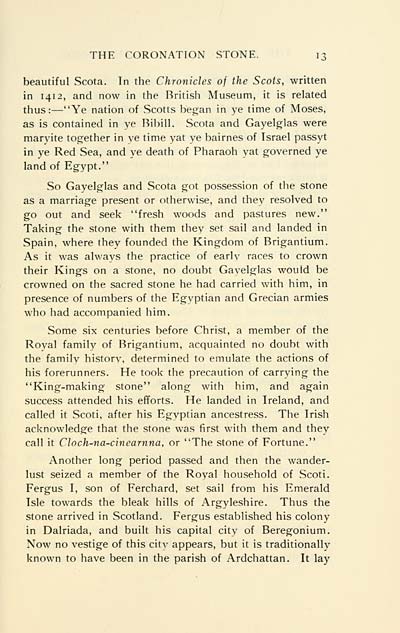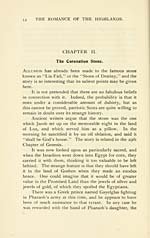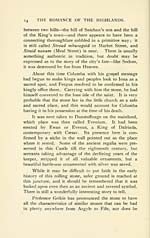Download files
Complete book:
Individual page:
Thumbnail gallery: Grid view | List view

THE CORONATION STONE. 13
beautiful Scota. In the Chronicles of the Scots, written
in 141 2, and now in the British Museum, it is related
thus: — "Ye nation of Scotts began in ye time of Moses,
as is contained in ye Ribill. Scota and Gayelglas were
maryite together in ve time yat ye bairnes of Israel passyt
in ye Red Sea, and ye death of Pharaoh yat governed ye
land of Egypt."
So Gayelglas and Scota got possession of the stone
as a marriage present or otherwise, and they resolved to
go out and seek "fresh woods and pastures new."
Taking the stone with them they set sail and landed in
Spain, where they founded the Kingdom of Brigantium.
As it was always the practice of early races to crown
their Kings on a stone, no doubt Gayelglas would be
crowned on the sacred stone he had carried with him, in
presence of numbers of the Egyptian and Grecian armies
who had accompanied him.
Some six centuries before Christ, a member of the
Royal family of Brigantium, acquainted no doubt with
the family history, determined to emulate the actions of
his forerunners. He took the precaution of carrying the
"King-making stone" along with him, and again
success attended his efforts. He landed in Ireland, and
called it Scoti, after his Egyptian ancestress. The Irish
acknowledge that the stone was first with them and they
call it Cloch-na-cinearnna, or "The stone of Fortune."
Another long period passed and then the wander-
lust seized a member of the Royal household of Scoti.
Fergus I, son of Ferchard, set sail from his Emerald
Isle towards the bleak hills of Argyleshire. Thus the
stone arrived in Scotland. Fergus established his colony
in Dalriada, and built his capital city of Beregonium.
Now no vestige of this city appears, but it is traditionally
known to have been in the parish of Ardchattan. It lay
beautiful Scota. In the Chronicles of the Scots, written
in 141 2, and now in the British Museum, it is related
thus: — "Ye nation of Scotts began in ye time of Moses,
as is contained in ye Ribill. Scota and Gayelglas were
maryite together in ve time yat ye bairnes of Israel passyt
in ye Red Sea, and ye death of Pharaoh yat governed ye
land of Egypt."
So Gayelglas and Scota got possession of the stone
as a marriage present or otherwise, and they resolved to
go out and seek "fresh woods and pastures new."
Taking the stone with them they set sail and landed in
Spain, where they founded the Kingdom of Brigantium.
As it was always the practice of early races to crown
their Kings on a stone, no doubt Gayelglas would be
crowned on the sacred stone he had carried with him, in
presence of numbers of the Egyptian and Grecian armies
who had accompanied him.
Some six centuries before Christ, a member of the
Royal family of Brigantium, acquainted no doubt with
the family history, determined to emulate the actions of
his forerunners. He took the precaution of carrying the
"King-making stone" along with him, and again
success attended his efforts. He landed in Ireland, and
called it Scoti, after his Egyptian ancestress. The Irish
acknowledge that the stone was first with them and they
call it Cloch-na-cinearnna, or "The stone of Fortune."
Another long period passed and then the wander-
lust seized a member of the Royal household of Scoti.
Fergus I, son of Ferchard, set sail from his Emerald
Isle towards the bleak hills of Argyleshire. Thus the
stone arrived in Scotland. Fergus established his colony
in Dalriada, and built his capital city of Beregonium.
Now no vestige of this city appears, but it is traditionally
known to have been in the parish of Ardchattan. It lay
Set display mode to: Large image | Transcription
Images and transcriptions on this page, including medium image downloads, may be used under the Creative Commons Attribution 4.0 International Licence unless otherwise stated. ![]()
| Early Gaelic Book Collections > Ossian Collection > Romance of the Highlands > (39) |
|---|
| Permanent URL | https://digital.nls.uk/81816093 |
|---|
| Description | Selected books from the Ossian Collection of 327 volumes, originally assembled by J. Norman Methven of Perth. Different editions and translations of James MacPherson's epic poem 'Ossian', some with a map of the 'Kingdom of Connor'. Also secondary material relating to Ossianic poetry and the Ossian controversy. |
|---|
| Description | Selected items from five 'Special and Named Printed Collections'. Includes books in Gaelic and other Celtic languages, works about the Gaels, their languages, literature, culture and history. |
|---|

